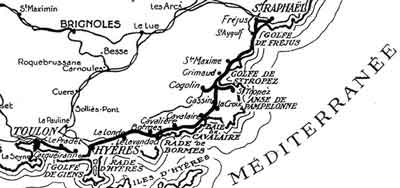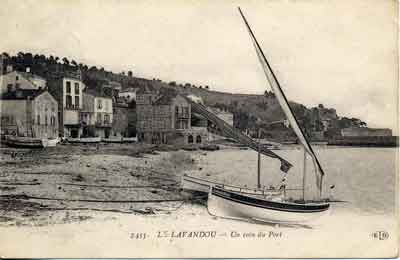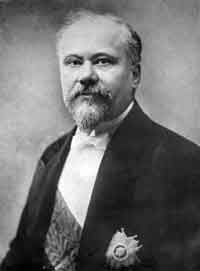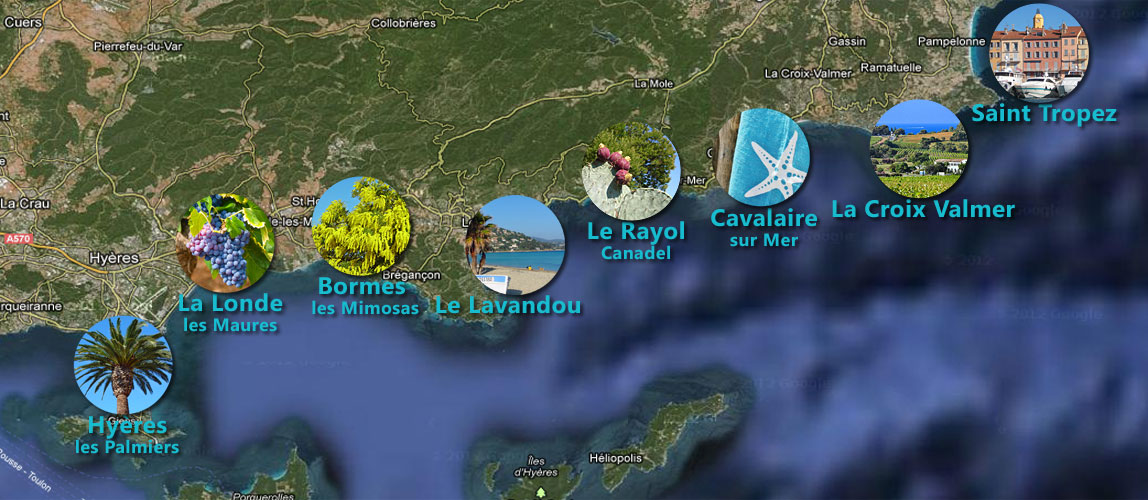 While Le Lavandou had been a section of the commune of Bormes since the 12th century, a revolution began in 1890 with the arrival of the Compagnie des chemins de fer du Sud de la France (SF), a railway line of 233 km serving the small coastal stations including Cavalière, la Fossette... The transformation would begin with the first tourists, members of the high Parisian aristocracy and as yet unknown artists, who would disembark at Le Lavandou, a hamlet which the Borméen bourgeoisie had left to the migrant Ligurian fisherman and Piedmont peasants. The first villas were built in Saint-Clair and Cavalière, which were still wild at the time, and hotels followed quite soon after. The little train, which travelled along the coast every day from Toulon to Saint-Raphaël, brought basketfuls of vegetables, flowers and wicker. In 20 years, the population rose from 350 to 770 inhabitants, achieving a certain degree of wealth and worrying the residents of Bormée, who had been there since the 15th century. At this rate, Le Lavandou seemed likely to overtake Bormes, While Le Lavandou had been a section of the commune of Bormes since the 12th century, a revolution began in 1890 with the arrival of the Compagnie des chemins de fer du Sud de la France (SF), a railway line of 233 km serving the small coastal stations including Cavalière, la Fossette... The transformation would begin with the first tourists, members of the high Parisian aristocracy and as yet unknown artists, who would disembark at Le Lavandou, a hamlet which the Borméen bourgeoisie had left to the migrant Ligurian fisherman and Piedmont peasants. The first villas were built in Saint-Clair and Cavalière, which were still wild at the time, and hotels followed quite soon after. The little train, which travelled along the coast every day from Toulon to Saint-Raphaël, brought basketfuls of vegetables, flowers and wicker. In 20 years, the population rose from 350 to 770 inhabitants, achieving a certain degree of wealth and worrying the residents of Bormée, who had been there since the 15th century. At this rate, Le Lavandou seemed likely to overtake Bormes, boosted by the increase in tourism and the mass arrival of farm workers, fishermen and construction workers who had emigrated from Italy. The idea of an administrative division was already gaining support in various quarters. Between 1907 and 1913, there were heated debates, mainly about the money Le Lavandou might make from its maritime location and Bormes from its guardianship. This separation deprived Bormes of much of its income, while Le Lavandou demanded more and more infrastructures which its guardian was reluctant to invest in. The emancipation of Le Lavandou was only a matter of time and...politics, in the face of economic differences. On 11 April 1909, Bormes Town Council took note of the uncontrollable situation and asked for Le Lavandou to be made into a separate commune with its own charges, debts, obligations to provide for its growth... The boundaries of this new commune still had to be set, under the supervision of the prefect, who appointed experts to help him. The new commune would inherit the whole coast, going back 1 km, from the Pramousquier boosted by the increase in tourism and the mass arrival of farm workers, fishermen and construction workers who had emigrated from Italy. The idea of an administrative division was already gaining support in various quarters. Between 1907 and 1913, there were heated debates, mainly about the money Le Lavandou might make from its maritime location and Bormes from its guardianship. This separation deprived Bormes of much of its income, while Le Lavandou demanded more and more infrastructures which its guardian was reluctant to invest in. The emancipation of Le Lavandou was only a matter of time and...politics, in the face of economic differences. On 11 April 1909, Bormes Town Council took note of the uncontrollable situation and asked for Le Lavandou to be made into a separate commune with its own charges, debts, obligations to provide for its growth... The boundaries of this new commune still had to be set, under the supervision of the prefect, who appointed experts to help him. The new commune would inherit the whole coast, going back 1 km, from the Pramousquier  stream to the Vieille stream. This was very beneficial for the modest landowners by the sea, who suddenly became richer than some wealthy residents of Bormes (income tax did not yet exist). At the new boundaries of the commune of Bormes, a resistance movement was organised by people who wanted to remain Borméens. This was the case of the Grande Bastide: a petition was submitted to the General Council of Var, demanding arbitration to curb the appetite of the Lavandourains. The Minister of the Interior became involved, under the influence of the Council of State, calling Le Lavandou’s independence into question. Finally, on 11 August 1907, Bormes Town Council agreed to divide the land and a law was published on 20 May 1913 in the Official Journal, making the section of Le Lavandou into a commune. On 25 May 1913, Raymond Poincaré, President of the Republic, promulgated the law. At the time, Le Lavandou had a population of 970 inhabitants. stream to the Vieille stream. This was very beneficial for the modest landowners by the sea, who suddenly became richer than some wealthy residents of Bormes (income tax did not yet exist). At the new boundaries of the commune of Bormes, a resistance movement was organised by people who wanted to remain Borméens. This was the case of the Grande Bastide: a petition was submitted to the General Council of Var, demanding arbitration to curb the appetite of the Lavandourains. The Minister of the Interior became involved, under the influence of the Council of State, calling Le Lavandou’s independence into question. Finally, on 11 August 1907, Bormes Town Council agreed to divide the land and a law was published on 20 May 1913 in the Official Journal, making the section of Le Lavandou into a commune. On 25 May 1913, Raymond Poincaré, President of the Republic, promulgated the law. At the time, Le Lavandou had a population of 970 inhabitants.
 In July, the first mayor, Doctor Paul Reynaud, was appointed just as World War One broke out, causing the new commune to collapse. Only the introduction of paid holiday in 1930 would drag it out of its torpor. In 1942, the Italian army, which already felt rather at home there, occupied Le Lavandou until 1944. Quite a few of our Provençal villages are in fact twinned with Italian villages. In July, the first mayor, Doctor Paul Reynaud, was appointed just as World War One broke out, causing the new commune to collapse. Only the introduction of paid holiday in 1930 would drag it out of its torpor. In 1942, the Italian army, which already felt rather at home there, occupied Le Lavandou until 1944. Quite a few of our Provençal villages are in fact twinned with Italian villages.
With hindsight, in the current political context, it’s nice to see the role played by the Italian immigrants who blended in with the local population, confined to the seaside by the grande bourgeoisie of Bormée, a town planted firmly on its rock with a focus on farming rather than the sea. All it took was the invention of horsepower and the intuition (and hard work) of the Italian migrants to transform the economic landscape of Le Lavandou. A sense of atavism persists to this day between the two communes, whose rivalry is still alive and well, despite a population of 4950 Lavandourains, most of whom are of European origin. On 25 May 2013, Le Lavandou will celebrate its hundredth birthday and commemorate its independence - to which Bormes will probably remain indifferent!
|


